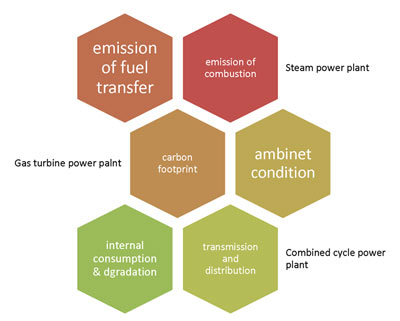Abbaspour, M.; Monavari, M.; Karbassi, A.R.; Kargari, N., (2011). Nuclear power and its role in CO2 emissions from the electricity generation sector in Iran. Energy Sources; Part A, 34(1): 43-52 (10 pages).
Alavipour, F.S.; Karimi, S.; Balist, J.; Khakian A.H., (2016). A geographic information system for gas power plant location using analytical hierarchy process and fuzzy logic. Global J. Environ. Sci. Manage., 2(2): 197-207 (11 pages)
Atilgan, B.; Azapagic, A., (2016). An integrated life cycle sustainability assessment of electricity generation in Turkey. Energy Policy. 93: 163-186 (4 pages).
Bonamente, E.; Pelliccia, L.; Merico, M.; Rinaldi, S.; Petrozzi, A., (2015). The multifunctional environmental energy tower: Carbon footprint and land use analysis of an integrated renewable Energy plant. Sustainability, 7: 13564-13584 (21 pages).
Brizmohun, R.; Ramjeawon, T.; Azapagic, A., (2015). Life cycle assessment of electricity generation on Mauritius. J. Cleaner Prod., 106: 565-575 (11 pages).
Cheng, K.; Genxing, P.; Smith, P.; Luo, T.; Li, L.; Zheng, J.; Zhang, X.; Xiaojun, H.; Ming, Y., (2011). Carbon footprint of China’s crop production—An estimation using agro-statistics data over 1993–2007. Agric. Ecosyst. Environ., 142; 231-237 (7 pages).
Gan, Y.; Liang, C.; Wang, X.; McConkey, B., (2011). Lowering carbon footprint of durum wheat by diversifying cropping systems. Field Crops Research. 122:199–206 (8 pages).
Georgakellos, A.D., (2012). Climate change external cost appraisal of electricity generation systems from a life cycle perspective: the case of Greece. J. Cleaner Prod., 32: 124-140 (16 pages)
Hong; L.; Pei Dong; Z.; Chunyu; H.; Gang; W.; 2007. Evaluating the effects of embodied energy in international trade on ecological footprint in China. Ecol. Econ., 62; 136-148 (13 pages).
IPCC; 2014. Climate Change: Mitigation. Contribution of Working Group III to the Fifth Assessment Report of the Intergovernmental Panel on Climate Change. Cambridge University Press; Cambridge. United Kingdom and NewYork; NY; USA.
IPCC; 2006. IPCC Guidelines for National Greenhouse Gas Inventories. IGES, Japan.
ISO; (2013). Greenhouse gases -- Carbon footprint of products -- Requirements and guidelines for quantification and communication. International Organization for Standardisation; Geneva, Switzerland.
Johnson, E., (2008). Disagreement over carbon footprints; A comparison of electric and LPG forklifts. Energy Policy. 36: 1569–1573 (5 pages).
Johnson; E., (2012). Carbon footprints of heating oil and LPG heating systems; Environ. Impact Assess. Rev., 35: 11–22 (12 pages).
Kehlhofer, R.; Hannemann, F.; Stirnimann, F.; Rukes, B., (2009). Gas and steam turbine power plants. 3rd ed. PennWell; Oklahama.
Kim, H.; Holme, P., (2015). Network Theory Integrated Life Cycle Assessment for an Electric Power System. Sustainability, 7: 10961-10975 (15 pages)
Li, F., (2014). A Cost Analysis of Carbon Dioxide Emission Reduction Strategies for New Plants in Michigan's Electric Power Sector. Dissertations. Michigan; Michigan Technology University.
Olkkonen, V.; Syri, S., (2016). Spatial and temporal variations of marginal electricity generation: the case of the Finnish; Nordic; and European energy systems up to 2030. J. Cleaner Prod., 126: 515-525 (11 pages).
Ozcan, M., (2016). Estimation of Turkey’s GHG emissions from electricity generation by fuel types. Renewable Sustainable Energy Rev., 53; 832-840 (8 pages).
Rashidi, Z.; Karbassi, AR.; Ataei, A.; Ifaei, P.; Samiee-Zafarghandi, R., (2012). Power plant design using gas produced by waste leachate treatment plant. Int. J. Environ. Res., 6 (4): 875-882 (7 pages).
Raj, R.; Ghandehariun, S.; Kumar, A.; Linwei, M., (2016). A well to wire life cycle assessment of Canadian shale gas for electricity generation in China. Energy., 111: 642-653 (12 pages)
Raymond, R.; Tan, R.; Ballacillo, J.; Aviso; K.; Culaba, A., (2009). Fuzzy multiple-objective approach to the optimization of bioenergy system footprints Chem. Eng. Res. Des., 8 7: 1162–1170 (8 pages).
Saltelli, A.; Rotto, M.; Andres, T., (2008). Global sensitivity analysis: the primer. 3rd ed. John Wiley and Sons; England.
Shafie, S.M.; Mahlia, T.M.I.; Masjuki, H.H.; Rismanchi, B., (2012). Life cycle assessment (LCA) of electricity generation from rice husk in Malaysia. Energy Procedia.,14: 499-504 (6 pages)
Silva, D.; Delai, I.; Montes, M.; Ometto; A., (2014). Life cycle assessment of the sugarcane bagasse electricity generation in Brazil. Renewable Sustainable Energy Rev., 32: 532–547 (16 pages).
Szabo, G.; Fazekas, I.; Szabo, S.; Buda,; T.; Paládi, M.; Kisari, K.; Kerényi, A., (2014). The Carbon Footprint of A Biogas Power Plant. Environ. Eng. Manage. J., 1: 11-13 (2 pages).
Tokunaga, K.; Konan, D.E., (2014). Home grown or imported? Biofuels life cycle GHG emissions in electricity generation and transportation. Appl. Energy . 125: 123–131 (9 pages).
Treyer, K.; Bauer, C., (2016). The environmental footprint of UAE’s electricity sector: combining life cycle assessment and scenario modeling. Renewable Sustainable Energy Rev., 55; 1234-1247 (14 pages).
Turconi, R.; Boldrin, A.; Astrup, T., (2013). Life cycle assessment of electricity generation technologies: overview; comparability and limitations. Renewable Sustainable Energy Rev., 28: 555-565 (11 pages).
Weber, C. L.; Clavin, C., (2012). Life cycle carbon footprint of shale gas; review of evidence and implications. Environ. Sci. Technol., 46: 5688−5695 (8 pages).
Weldemichael, Y.; Assefa, G.; (2016). Assessing the energy production and GHG (greenhouse gas) emissions mitigation potential of biomass resources for Alberta. J. Cleaner Prod., 112: 4257-4264 (8 pages).



Letters to Editor
[1] Letters that include statements of statistics, facts, research, or theories should include appropriate references, although more than three are discouraged.
[2] Letters that are personal attacks on an author rather than thoughtful criticism of the author’s ideas will not be considered for publication.
[3] Letters can be no more than 300 words in length.
[4] Letter writers should include a statement at the beginning of the letter stating that it is being submitted either for publication or not.
[5] Anonymous letters will not be considered.
[6] Letter writers must include their city and state of residence or work.
[7] Letters will be edited for clarity and length.
Send comment about this article